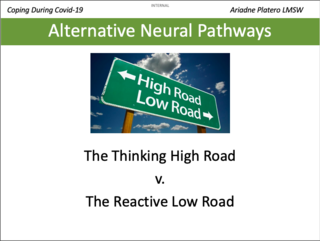Sometimes the reactivity arises from the fact that endless stepping back, calming down and reframing has got you absolutely nowhere.
Understanding and Taming Your Reactivity
Stay on the thinking high road, not the reactive low road.
Posted Jan 28, 2021
Reactivity: Have you ever suddenly lost control in a disagreement and later wondered what happened? In all my years working with families, couples, and individuals, one of the most consistently impactful discussions is the one about reactivity. There is little disagreement that flying off the handle or being quick to be hurt or to hurt others makes for difficult relationships, or, at the very least, difficult moments in these relationships. Neither side feels good during or after an interaction that has escalated into shouts, recriminations, and accusations. Phrases starting with “you always…” or “you never…” rarely end well. Occasionally, outbursts can feel good in the moment—a release of pent-up emotion, a "finally telling it like it is" but, whether we’ve become defensive or gone on the attack, the upshot is usually the same: shame, disappointment, and alienation.
The goal of focusing on reactivity is to help each person understand why and how we may be particularly reactive in certain instances. Self-awareness and understanding are key to our being able to react differently and better, to being able to break our repetitive patterns of responses.

There are two parts to this. The first is to understand what is going on neurologically that makes us so reactive and why it’s physiologically hard to resist impulsive reactivity or to be reasonable when we’re upset. The second part is to help each person identify and understand the individual triggers that make them vulnerable to this cycle. Only once we have this two-part foundation, can we start to put strategies and habits in place to control this reactivity and to reset our responses in similar situations. If we can learn to do it differently, we end up with better outcomes and stronger connections. After all, the goal of any relationship, whether it be friendship, marriage, or between family members, is not that we should never disagree but that we can develop a reliable and positive way of dealing with those inevitable moments of discord.
Emotions and Brain 101 Recap: I like to start this discussion with an Emotions 101 recap. We have primary, basic emotions, among them anger, fear, joy, and sadness. These evolved for their survival value and they tend to be swift and crude. There are many more sophisticated secondary emotions such as love, gratitude, anxiety, envy, hope, pride, etc. and these are more variable among people and often influenced by the societies we live in. Then we have a Brain 101 recap at its most basic. There are two parts of the brain I want to focus on—the amygdala, which is responsible for emotional response including flight or fight reactions, and the pre-frontal cortex, which is like your brain manager, where the upper-level thinking is done including executive functioning, judgment, analysis, impulse control, and thoughtfulness.
Thinking High Road vs. Reactive Low Road: In any given moment, we are bombarded with an enormous number of inputs. In order not to be overwhelmed, our brains are trained to filter out most of them and focus on what is salient. As we process these inputs—sights, sounds, smells, language— we will sometimes react thoughtfully and reasonably, assessing what we see or hear and responding with calm having processed them through the pre-frontal cortex—the Thinking High Road. And sometimes, we get quickly upset and react accordingly. This is when the inputs have bypassed our pre-frontal cortex and gone directly to the amygdala—the Reactive Low Road.

What controls how we process these inputs? We head out on the Reactive Low Road when we get highly emotional, our heart rate rises and we are flooded with cortisol. And here’s the rub. There are times when this is obvious to us, when we know what has made us upset, frightened, or angry (those primary emotions). But at other times, especially when conversations or situations are moving fast, we don’t even realize how we got so upset. This is usually when something said or seen has "triggered" an old and raw emotion, maybe a past trauma or familiar negative pattern, and our brains get hijacked. At this point, we are no longer able to process carefully and thoughtfully. And we are no longer able to stand down and take stock.
If you’ve ever been in a situation when you find yourself instantly angry, reacting extremely to a minor incident, unable to calm down in an argument, this is when your more rational responses are being hijacked by your emotional response. And while you stay flooded, you literally cannot process your thoughts in the more sophisticated part of your brain.
The original purpose of this quick response was to increase our chances of survival in times of danger—by running away even before you’d really processed the rustle of leaves, you may have saved yourself from being a saber-toothed tiger’s lunch. This was helpful for our ancestors but not so much for us in the 21st century. We’re basically walking around with a brain system and reactivity designed for the Paleolithic Age.
What to do? In the moment, slow it down. Take time. Step away from the interaction and start to breathe slowly and intentionally; take a walk; give yourself a time out. This way, we give our system the opportunity to calm down, bringing down our stress hormone levels. When we calm down, we are able to access our brain manager and the more nuanced thoughtfulness that it is capable of. At that point, we can re-engage, more slowly this time, and work through the previous interaction with a more rational response.
In the longer term, there are two things to focus on. One is to understand our individual triggers. The second is to work on bringing our overall stress levels under control with self-care—breathing, meditation, good nutrition, and exercise, all of which help to make us less reactive.
Next month’s Reflect and Reset blog post will look at identifying triggers and stress reduction.



















